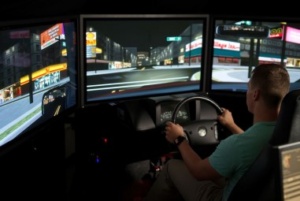BOISE – Many drivers have experienced the frightening feeling of becoming drowsy behind the wheel. But according to new research by the AAA Foundation for Traffic Safety, most drivers tend to underestimate how tired they really are, which could lead to risky driving that puts everyone in harm’s way.
In a recent AAA study, researchers induced drowsiness during a 150-mile simulated nighttime highway driving experiment. Every 20 miles, there was a simulated “rest area,” where participants could stop for a nap, a snack or some coffee, or to take a stretch break. A monetary incentive was used to encourage drivers to complete the simulation as quickly as possible without crashing.

The results were shocking. When drivers rated their level of drowsiness as low, 75% of them were, in fact, moderately or severely drowsy based on an objective measure of how long their eyes were closed per minute of driving. Further, even when drivers’ eyes were closed for 15 seconds or more per minute, one in four still rated their level of drowsiness as low.
AAA’s new research arrives in time for the upcoming switch to Daylight Savings, when many drivers’ body clocks will be affected by the change.
“The end result of drowsiness can be the same as the misuse of alcohol – serious impairment that puts lives at risk,” says AAA Idaho public affairs director Matthew Conde. “Because they aren’t as alert, sleepy drivers may not attempt to brake or swerve to avoid a crash, which could lead to a collision at higher impact speeds. Or a drowsy driver may become startled and lose control of the vehicle. Either way, it’s a recipe for disaster.”
AAA research indicates that as many as 1 in 5 police-reported fatal crashes involves drowsy driving.
Drivers continue to take a “do as I say, not as I do” approach to drowsy driving. In AAA’s most recent Traffic Safety Culture Index, 95% of drivers said that drowsy driving is very or extremely dangerous, but 19% admitted to driving when they were so tired that they had a hard time keeping their eyes open at least once in the past 30 days.
AAA urges drivers to recognize the signs of drowsiness, including having trouble keeping your eyes open, drifting from your lane, and not remembering the last few miles driven.
“Caffeine may have a temporary effect, but there’s no substitute for a good night’s sleep,” Conde said. “Drivers should get at least seven hours of rest before a long road trip, avoid heavy meals while driving, and either take rest breaks every two hours or 100 miles or take turns driving.”
Drivers should also travel at times of day when they’re normally awake and ask their doctor how the medications they use may affect their ability to stay alert behind the wheel.
During AAA’s study, approximately half of all participants completed the experiment without taking any breaks, 39% took one break, and 11% took two breaks. Among those who took breaks, 40% said that feeling sleepy was the reason for the break.
When study participants rated themselves as extremely drowsy, an astonishing 75% chose to continue driving without taking a break.
School zone safety
Because it will be darker in the morning due to the time change, AAA reminds drivers to:
- Slow down. Speed limits are reduced in school zones to protect students. A pedestrian struck by a vehicle traveling at 35 mph is nearly 66% more likely to be killed than by a vehicle traveling at 25 mph.
- Stay alert, particularly in school zones and residential neighborhoods. Actively scan the road, looking for children who may cross the street or dart between vehicles.
“Our hope is that drivers will take our drowsy driving research to heart and recognize that they aren’t the exception to the rule when it comes to safe driving decisions,” Conde said. “Simply put, if you snooze, we all lose.”

